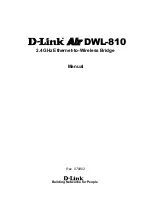
IV-1-3 IPsec General Setup
IV-1-3 IPsec General Setup
In
IPsec General Setup,
there are two major parts of configuration.
There are two phases of IPsec.
Phase 1: negotiation of IKE parameters including encryption, hash, Diffie-Hellman
parameter values, and lifetime to protect the following IKE exchange, authentication
of both peers using either a Pre-Shared Key or Digital Signature (x.509). The peer that
starts the negotiation proposes all its policies to the remote peer and then remote
peer tries to find a highest-priority match with its policies. Eventually to set up a
secure tunnel for IKE Phase 2.
Phase 2: negotiation IPsec security methods including Authentication Header (AH) or
Encapsulating Security Payload (ESP) for the following IKE exchange and mutual
examination of the secure tunnel establishment.
There are two encapsulation methods used in IPsec,
Transport
and
Tunnel
. The
Transport
mode will add the AH/ESP payload and use original IP header to encapsulate the data
payload only. It can just apply to local packet, e.g., L2TP over IPsec. The
Tunnel
mode will
not only add the AH/ESP payload but also use a new IP header (Tunneled IP header) to
encapsulate the whole original IP packet.
Authentication Header (AH) provides data authentication and integrity for IP packets passed
between VPN peers. This is achieved by a keyed one-way hash function to the packet to
create a message digest. This digest will be put in the AH and transmitted along with
packets. On the receiving side, the peer will perform the same one-way hash on the packet
and compare the value with the one in the AH it receives.
Encapsulating Security Payload (ESP) is a security protocol that provides data confidentiality
and protection with optional authentication and replay detection service.
Available settings are explained as follows:
Item
Description
IKE Authentication
Method
This usually applies to those are remote dial-in user or node
(LAN-to-LAN) which uses dynamic IP address and IPsec-
related VPN connections such as L2TP over IPsec and IPsec
tunnel. There are two methods offered by Vigor router for
you to authenticate the incoming data coming from remote
Vigor2762 Series User’s Guide
196
Summary of Contents for Vigor2762 series
Page 1: ......
Page 135: ...Vigor2762 Series User s Guide 125 ...
Page 201: ...This page is left blank Vigor2762 Series User s Guide 191 ...
Page 261: ...Vigor2762 Series User s Guide 251 ...
Page 311: ...Vigor2762 Series User s Guide 301 ...
Page 326: ...Vigor2762 Series User s Guide 316 ...
Page 330: ...Vigor2762 Series User s Guide 320 ...
Page 408: ...This page is left blank Vigor2762 Series User s Guide 398 ...
Page 435: ...Vigor2762 Series User s Guide 425 ...
Page 444: ...Vigor2762 Series User s Guide 434 ...
Page 448: ...Vigor2762 Series User s Guide 438 ...
Page 450: ...Part IX DrayTek Tools Part IX DrayTek Tools Vigor2762 Series User s Guide 440 ...
Page 455: ...This page is left blank Vigor2762 Series User s Guide 445 ...
Page 456: ...Part X Telnet Commands Part X Telnet Commands Vigor2762 Series User s Guide 446 ...
Page 553: ... scr Vigor2762 Series User s Guide 543 ...
Page 607: ...Vigor2762 Series User s Guide 597 ...
Page 622: ...Vigor2762 Series User s Guide 612 ...
















































